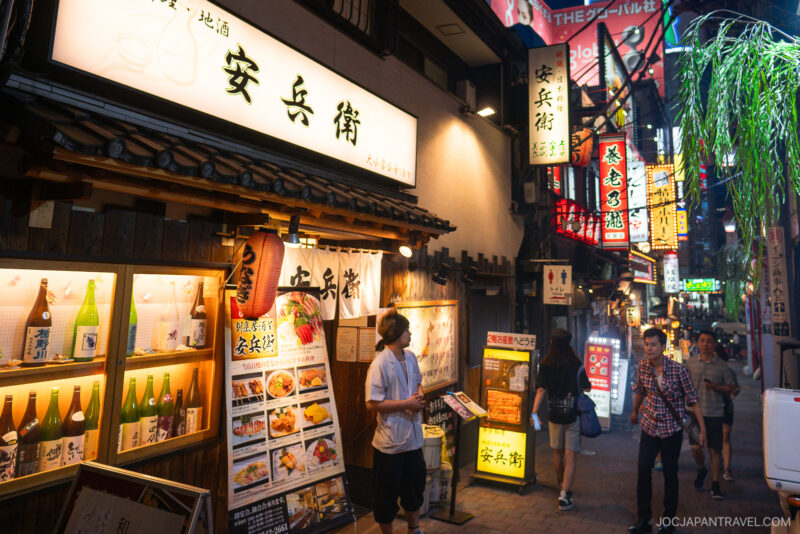This post may contain affiliate links. Please read our disclosure policy.
Step into Memory Lane (Omoide Yokocho), a Shinjuku alley where tiny bars and yakitori grills recreate the flavors and atmosphere of postwar Tokyo.

What is Memory Lane?
Memory Lane, known in Japanese as Omoide Yokocho (思い出横丁), sits just north of Shinjuku Station’s west exit. Locals also call it Shinjuku Yakitori Alley because it’s home to more than 70 tiny eateries. Most are only large enough for six to eight people, making it one of the most intimate dining spots in Tokyo.
The alley dates back to the years after World War II, when food stalls sprang up to serve cheap and filling meals. Yakitori (grilled chicken skewers) quickly became a favorite. Even though the area was rebuilt after a 1999 fire, its nostalgic atmosphere remains, with smoky air, lantern-lit signs, and sizzling grills.
When you visit, look for the sign marked 思い出横丁 instead of “Yakitori Alley.” The name “Memory Lane” reflects its roots in postwar Tokyo.
What is Yakitori?

Yakitori (焼き鳥) means “grilled bird” in Japanese. It usually refers to skewered pieces of chicken cooked over charcoal, though you’ll also find vegetables, seafood, or even beef on skewers.
Each shop has its own flavor style. Some serve their skewers with simple salt (shio), while others brush them with a sweet-savory soy sauce blend called tare. Popular cuts include thigh, skin, liver, and heart, but you might also encounter creative options like bacon-wrapped quail eggs or mushrooms.
Part of the fun is ordering a variety of skewers and comparing the flavors. Pair them with beer, sake, or a highball for the full izakaya experience.
🍻 Want to recreate a taste of Japanese pub food at home? Don’t miss Nami’s Yakitori Recipe! Gather family and friends to enjoy delicious BBQ and good times together.
Our Walk Through Memory Lane

On our visit, the smoky air was thick with the scent of grilled chicken, and lanterns glowed above narrow doorways. It felt like stepping into another time.
Watching grill masters at work and hearing the chatter of locals packed into tiny bars was an experience in itself.
Tips for Visiting Memory Lane

- Arrive early or be ready to wait. Most shops fill quickly, especially on weekends.
- Expect variety. Not every place serves yakitori. Some specialize in ramen, gyoza, or izakaya dishes.
- Enjoy people watching. The small counters let you see the action up close.
How to Get to Memory Lane (Omoide Yokocho)
By Train
- JR Lines: Yamanote, Chuo, Sobu, Saikyo to Shinjuku Station
- Private/Metro: Keio Line, Odakyu Line, Toei Oedo Line, Tokyo Metro Marunouchi Line to Shinjuku Station
- From JR Shinjuku Station, use the West Exit and walk about 2 minutes toward the tracks on the north side. Look for the green sign that reads 思い出横丁 (Omoide Yokocho). The alley sits just outside the station along the elevated rails.
Hours and Tips
- Hours vary by shop, but many open late afternoon and stay open until midnight or later
- Small interiors and narrow lanes; large luggage and strollers are not ideal
- Queues form on weekends; arrive early evening on weekdays for shorter waits
Pro Tip: If a place is full, check the next doorway; many counters seat only 6–8 guests, and turnover can be quick.
Our Final Take on Memory Lane

If you want a glimpse of Tokyo’s past and a taste of authentic street food, Memory Lane is a must-see. It’s smoky, noisy, and crowded, but that’s what makes it so memorable. Even if you don’t stop to eat, walking through this Shinjuku landmark is an experience that captures the spirit of old Tokyo.
More to Explore Nearby
After enjoying smoky yakitori skewers and retro vibes in Memory Lane, explore more of Shinjuku and Tokyo with these nearby food and nightlife experiences.
- Zauo Shinjuku Restaurant – Hook your own fish and enjoy it cooked fresh at this fun, interactive seafood restaurant just minutes from Memory Lane.
- Shibuya Center Gai – A quick train ride brings you to this youth-focused street lined with snacks, sneaker shops, and late-night energy.
- Takeshita Street – Head to Harajuku for quirky fashion, rainbow sweets, and teen pop culture in one of Tokyo’s most photogenic spots.





I never experienced Tokyo the way you describe Memory Lane, because I was just a child when I visited.
But I remember the smell of Yakitori in the streets of my Kunitachi neighborhood during festivals. At night, the colorful lanterns would make everything bright, including the stalls of food vendors. Everyone wore colorful kimonos. There was music on the larger streets. Drumbeats. The shops where I bought small wrapped pieces of chewy brown candy were all open, meaning that their bins and racks stuck out into the streets of my neighborhood.
The yakitori smell has haunted me ever since. As an adult, I looked for this food in “stateside” Japanese restaurants, but never found it on any menu. There was Teriyaki, but not yakitori. Now, thanks to Namiko, I have recipes!